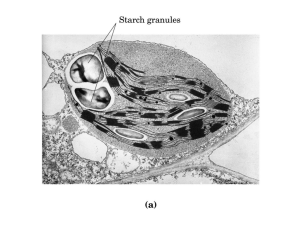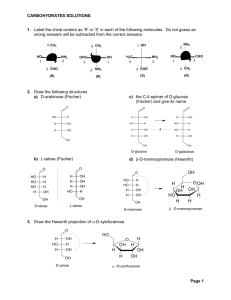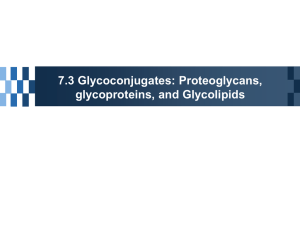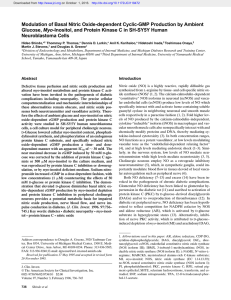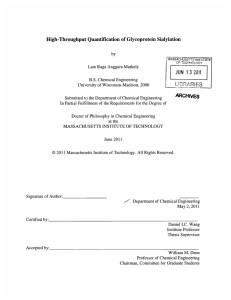(1-4) D-glucose, a
advertisement
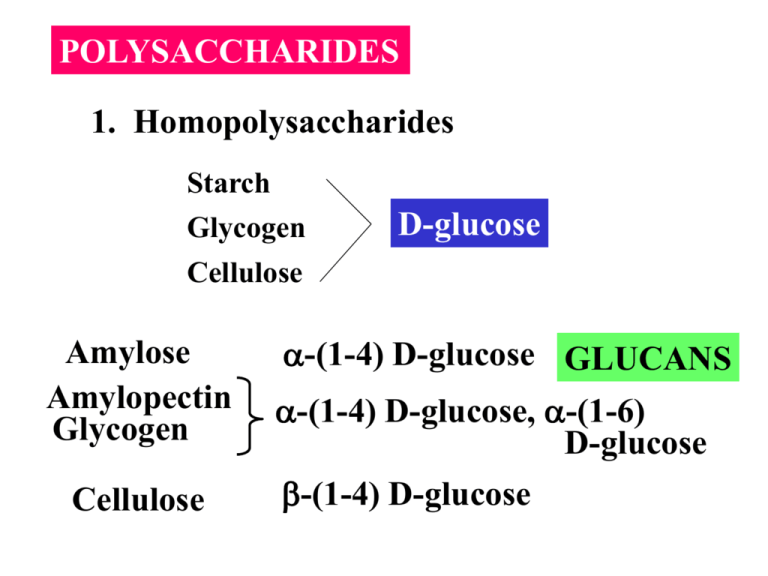
POLYSACCHARIDES 1. Homopolysaccharides Starch Glycogen D-glucose Cellulose Amylose Amylopectin Glycogen Cellulose a-(1-4) D-glucose GLUCANS a-(1-4) D-glucose, a-(1-6) D-glucose b-(1-4) D-glucose HOMOPOLYSACCHARIDES Branch point GLYCOGEN Non-reducing Ends Reducing End Glycogen is built for glucose storage and rapid glucose release….. Highly branched Macromolecular Multi ends Cellulose is built for support. The molecules emphasizes extended chains with close packing b-1-4 linkage Alternate glucose units are flipped Digestive Enzymes Starch Amylose Amylases Break internal a-1-4 bonds a-1-4 glycosidic bond Non Reducing End Will not digest Cellulose a -glucosidase Maltase Maltose and maltotriose are the major products D-glucose units Debranching Enzyme Limit Dextrin amylases Amylopectin or Glycogen a-1-4, a-1-6 glucosidase or Debranching enzyme Glycogen Phosphorylase: Inserts the elements of phosphate across the glycosidic bond-NOT Digestive HETEROPOLYSACCHARIDES Nature’s Lubricants Slimy, mucous, substances Salivary Secretions Vitreous Humor Joints Synovial fluid GLYCOSAMINOGLYCANS (GAGS) Chondroitin Sulfate Hyaluronic Acid Keratan Sulfate Dermatin Sulfate Heparin Repeating unit is a Negatively charged disaccharide Heteropolysaccharides Amino Sugars CH2OH O NH Amine group on carbon 2 Acetyl group on amine C=O CH3 Amino sugars are always acetylated HETEROPOLYSACCHARIDES Uronic Acids Sulfate Sugars CH2OSO3= O COO Negative Charge O NH C=O CH3 D-glucuronic acid (GlcUA) N-acetylgalactosamine6-sulfate (GalNac-6s) b 1-3 b 1-4 CH2OSO3= COO O CH2OSO3= O O O NH C=O CH3 Repeating unit of CHONDROITIN 6 SULFATE COO O O O NH C=O CH3 Repeating disaccharide Proteoglycans proteins with one or more covalently linked GAG chains Link Protein Core protein GAG Hyaluronate GLYCOPROTEINS CH2OH O NH C=O CH2 C N Protein is the Major component N C O Asparagine linkage Sia Sia Gal Gal GlcNAc GlcNAc Man Man Man Typical Oligosaccharide Chain in a Glycoprotein GlcNAc GlcNAc Asn Bi-Antennary Carbohydrates in Proteins are Information Molecules Diversity allows recognition patterns to vary: a or b configuration on C-1 Linking -OH groups on different positions Types of sugars and presence or absence of branching Presence or absence of sialic acid Patterns guide biological processes Carbohydrate-binding proteins (lectins) recognize specific patterns or features and interact with specific sites on oligosaccharide chains Carbohydrate-binding Proteins (lectins) Recognize oligosaccharide chains on cell membranes Examples: Plant lectins: concanavalin A (a-mannose residues) wheat germ agglutinin (GlcNAc-GlcNAc-GlcNac) peanut lectin (Gal (b1-3)-GalNac) [Physiological role uncertain; binding of rhizobium bacteria to root hairs for nitrogen fixation is one function]. Asialoglycoprotein Receptor on surface of liver cells: Allows liver to remove old proteins that have lost their sialic acid from the circulation Exposed galactose residue is the signal for removal Mannose-6-Phosphate Receptor: Targets proteins for destruction in the lysosomes ZP3 Receptor on surface of sperm: ZP3 glycoprotein in extracellular coat of ovulated eggs a-linked galactose at the non-reducing end Binding triggers release of sperm enzymes, dissolves zona pellucida to allow sperm to enter Selectins: (Carbohydrate-binding adhesive proteins) Surface of neutrophils, lymphocytes, leukocytes Interacts with carbohydrates on endothelial cells, lymph-node vessels and platelets E-selectins recognize injured endothelial cells Binds lymphocytes to endothelial cells in order to penetrate into underlying cell layer Creates and perpetuates an inflammatory condition L-selectins allow circulating lymphocytes to return to sites in lymph nodes from which they were derived… return is called homing Binding mediated by Ca2+ Prevented by removal of sialic acid

